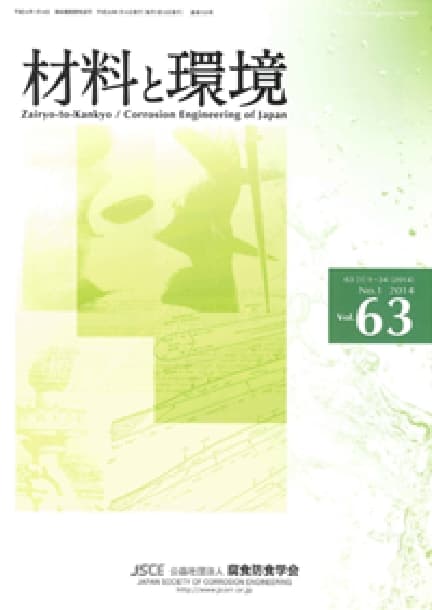- TOP
- Zairyo-to-Kankyo
- Vol. 71 (2022), No. 4
Zairyo-to-Kankyo Vol. 71 (2022), No. 4
Backnumber
-
Vol. 74 (2025)
-
Vol. 73 (2024)
-
Vol. 72 (2023)
-
Vol. 71 (2022)
-
Vol. 70 (2021)
-
Vol. 69 (2020)
-
Vol. 68 (2019)
-
Vol. 67 (2018)
-
Vol. 66 (2017)
-
Vol. 65 (2016)
-
Vol. 64 (2015)
-
Vol. 63 (2014)
-
Vol. 62 (2013)
-
Vol. 61 (2012)
-
Vol. 60 (2011)
-
Vol. 59 (2010)
-
Vol. 58 (2009)
-
Vol. 57 (2008)
-
Vol. 56 (2007)
-
Vol. 55 (2006)
-
Vol. 54 (2005)
-
Vol. 53 (2004)
-
Vol. 52 (2003)
-
Vol. 51 (2002)
-
Vol. 50 (2001)
-
Vol. 49 (2000)
-
Vol. 48 (1999)
-
Vol. 47 (1998)
-
Vol. 46 (1997)
-
Vol. 45 (1996)
-
Vol. 44 (1995)
-
Vol. 43 (1994)
-
Vol. 42 (1993)
-
Vol. 41 (1992)
-
Vol. 40 (1991)
Keyword Ranking
18 Dec. (Last 30 Days)
Zairyo-to-Kankyo Vol. 71 (2022), No. 4
Protection of Iron Corrosion by Coverage with an Ultrathin Two-dimensional Polymer Coating Prepared by Chemical Modification of Carboxylate Ion Self-Assembled Monolayer Adsorbed on Passivated Iron
Tadashi Shimura, Kunitsugu Aramaki
pp. 105-109
DOI:
10.3323/jcorr.71.105Abstract
An ultrathin (nm order of the thickness), two-dimensional polymer coating was prepared on the passive film formed in a borate buffer at pH 8.49 by modification of 16-hydroxyhexadecanoate anion HO(CH2)15CO2- self-assembled monolayer with 1, 2-bis(triethoxysilyl)ethane (C2H5O)3Si(CH2)2Si(OC2H5)3 and octadecyltriethoxysilane C18H37Si(OC2H5)3. The electrode covered with the passive film and two-dimensional polymer was treated in 0.1 M NaNO3 to heal the passive film. The time for passive film breakdown of the complex film, tbd was markedly long, expecting more than 1000 h and the protection efficiency, P(%) was extremely high, more than 99.9%, unless the passive film breakdown occurred. Complete protection against passive film breakdown and markedly high value of P can be investigation of ultimate protective coatings for SDGs in future.
Effect of 90Sr Dissolved Solution on Corrosion Potential of Type 316L Stainless Steel
Takahito Aoyama, Chiaki Kato, Tomonori Sato, Naruto Sano, Naoki Yamashita, Fumiyoshi Ueno
pp. 110-115
DOI:
10.3323/jcorr.71.110Abstract
In order to analyze the effect of β-rays on corrosion, the effect of dissolved 90Sr on the corrosion potential of Type 316L stainless steel was investigated. The 90Sr-containing HCl was dropped into the diluted artificial seawater while the corrosion potential was measured. The solution was dropped in two times and the radioactivity of the solution was adjusted to be 0.15 MBq and 1.5 MBq, respectively. As a result, it was found that the potential of Type 316L stainless steel was increased by the drop of 90Sr-containing HCl.
Measurement of Surface Hydrogen Concentration of Steel Bar with Electrochemical Hydrogen Permeation Method
Ryuta Ishii, Takuya Kamisho, Norihiro Fujimoto, Masayuki Tsuda
pp. 116-120
DOI:
10.3323/jcorr.71.116Abstract
For accurately evaluating the risk of hydrogen embrittlement in steels, the hydrogen concentration near the steel surfaces needs to be determined. An electrochemical hydrogen permeation method to measure sub-surface hydrogen concentration can use steel sheets but not steel bars. Because iron oxide and working strain generated in the manufacturing process that affects hydrogen permeability are present on the sub-surface of steel bars, we need to evaluate steel bars directly. In this report, we research an electrochemical hydrogen permeation method and method to determine the surface hydrogen concentration for steel bars.
Electrochemical Behavior of Carbon Steels Under Thickness-controlled Solution Layer
Yuichiro Monma, Masatoshi Sakairi, Fumiyoshi Ueno, Kyohei Otani
pp. 121-125
DOI:
10.3323/jcorr.71.121Abstract
The effect of solution layer thickness on the atmospheric corrosion of carbon steel was investigated using novel devices fabricated by a 3D printer. These novel devices allowed us to control the solution layer thickness precisely. Potentiodynamic polarization measurements were performed under thickness-controlled solution layer, and oxygen diffusion limiting current density(jlim) and anodic current density(janode) were measured. As the solution layer becomes thinner, jlim increased and janode decreased. This result indicates that corrosion accelerates when the solution layer becomes thinner. The diffusion coefficient of oxygen was calculated as 3.20×10-5 cm2 s-1 from the relationship between jlim and solution layer thickness, and the critical diffusion thickness was estimated to be 0.87 mm.
Article Access Ranking
18 Dec. (Last 30 Days)
-
Delayed Fracture Mechanism of 1700 MPa-Class Quenched and Tempered Bolt under Atmospheric Corrosion Environment
Tetsu-to-Hagané Advance Publication
-
Perspectives on the Promising Pathways to Zero Carbon Emissions in the Steel Industry toward 2050
ISIJ International Vol.65(2025), No.2
-
Effect of B on Surface Oxidation Behavior and Phosphatability of Si-Mn-added Cold-Rolled Steel Sheets
ISIJ International Advance Publication
-
Factors Influencing the Bonding Phase Structure of Iron Ore Sinters
ISIJ International Vol.43(2003), No.9
-
Effect of microstructural heterogeneity on fatigue limit of as-quenched low-carbon low-alloy martensitic steel
ISIJ International Advance Publication
-
Prussian blue as a fully reversible hydrogenochromic material for visualizing hydrogen distribution in Fe sheet
ISIJ International Advance Publication
-
Metallurgical Aspects on Interstitial Free Sheet Steel From Industrial Viewpoints
ISIJ International Vol.34(1994), No.1
-
Microstructures and Reduction Properties of High CaO Concentration Sintered Ore
ISIJ International Advance Publication
-
Influence of Antimony on the Oxidation Characteristics of 65Mn Steel
ISIJ International Advance Publication
-
From plasticity to fracture in pearlitic microstructures: Atomistic study of cementite thickness and deformation localization
ISIJ International Advance Publication
You can use this feature after you logged into the site.
Please click the button below.










